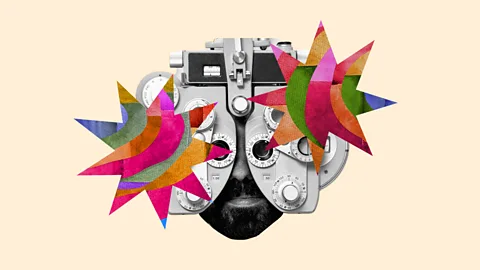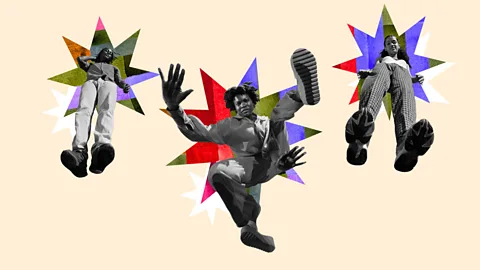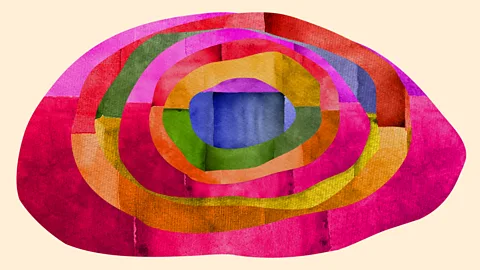The people who 'see' foreign languages: How synaesthesia can help language learning
 Serenity Strull/ BBC/ Getty Images
Serenity Strull/ BBC/ Getty ImagesSynaesthesia is a neurological condition found to enhance memory and learning. Now, scientists say seeing in colour could help when it comes to learning a second language.
My mother's name is the colour of milk. The strings of an acoustic guitar, when strummed, play the warm yellow of honeycomb. The sound is flat, hard and smooth. And Monday is pink. These sensations are always the same, and always present. This is synaesthesia – in my case grapheme-colour synaesthesia, sound-colour synaesthesia and sound-texture synaesthesia.
Like many synaesthetes, I discovered at a young age I had a flair for both music and languages. In music, it wasn't the physical act of performing I excelled at, but composition. I went on to become a composer for short films and dance theatre, and a sound editor for television. Writing music felt a lot like a language to me, as I "saw" the colours of the sounds in a similar way. I also studied French, German, Spanish and linguistics – the colour of language helping me to remember words as well as the patterns of grammar.
Synaesthesia is a neurological phenomenon that causes an estimated 4.4% of people to experience the world as a cacophony of sensations. Around 60 different types of synaesthesia have been identified, but there could be more than 100, with some types experienced in clusters.
The condition is thought to be caused by genetically inherited traits that affect the structural and functional development of the brain. Increased communication between sensory regions in the brain means, for example, words can stimulate taste, sequences of numbers may be perceived in spatial arrangements, or the feel of textures might conjure emotions.
Synaesthesia is not considered to be a neurological disorder and – although it has been linked to neurodevelopmental and mental health conditions including autism, anxiety and schizophrenia – it is described as an "alternative perceptual reality" and generally thought to be beneficial.
"When I was younger I knew I saw the world in a different way, and my way of describing that to others was 'colourful'," says Smadar Frisch.
Frisch, who has grapheme-colour synaesthesia, sound-colour synaesthesia and lexical–gustatory synaesthesia – where words have taste – explores the world of senses through her podcast, Chromatic Minds, and is currently writing her first book on the subject. "Learning in school was too much for me sensory-wise," she says. "It is very difficult trying to solve an equation when all the colouring of a series of numbers was a psychedelic blast."
This explosion of colour, says Frisch, would cause her to lose focus and forget what she was doing. "[It was the] same with language. The words' colours, music and taste sensations ignited me and I wanted to express myself so much – that I lost focus."
 Serenity Strull/ BBC/ Getty Images
Serenity Strull/ BBC/ Getty ImagesIt wasn't until she'd almost finished high school that she came across Richard Cytowic and David Eagleman's book, Wednesday is Indigo blue. "My initial thought was that Wednesday is actually orange – and I needed to get this book." This was a turning point for Frisch. "I finally understood how my synaesthete brain is linked and wired. And I thought to myself, this phenomenon is amazing. I can use the colours to help me learn, rather than confuse me."
Frisch developed a colour coding system to help her learn new languages fluently and quickly. Studying languages no longer felt confusing but "organised", she says. "And it worked! My whole world changed. I went on to learn the thing my brain was meant to excel in: languages."
Frisch says she was able to learn French and Spanish to an advanced level in just two months. "I scored 90+ on each [French and Spanish] exam," she says. These exams were part of her Te'udat Bagrut – the qualification gained on completing high school in Isreal. Today Frisch says she can speak seven languages fluently – and learn any language she wants "with no difficulty, in a short matter of time".
Julia Simner is director of the Multisense Synaesthesia Research laboratory at the University of Sussex in the UK. She and her team tested around 6,000 children who were six to 10 years old. "We screened each one individually for synaesthesia, and then gave [them] a battery of tests to determine what skills come with synaesthesia," she says.
The study found that the children with synaesthesia were better in a number of skills than the children without – skills which, according to Simner, would "certainly help both first and second language learning".
"Specifically, they were significantly better in receptive vocabulary (how many words they could understand), productive vocabulary (how many words they knew how to say), short term memory store, attention to detail and creativity," Simner says. "These syn-linked skills predict that we might well expect second-language learning to be easier for someone with synaesthesia."
Having synaesthetic colours, she says, makes letters more memorable. And the synaesthesia colours can pass from one language into the second language learned, making words in the second language more memorable too. "The way these colours seep across languages can either be via the way the letter looks or the way the letter sounds," says Simner. "It's like the colour scaffolds across from one language to another."
In 2019, another experiment led by psychologists at the University of Toronto, Canada, found grapheme-colour synaesthesia, where each letter and number has its own distinct colour, provides a significant advantage in statistical learning – allowing a person to "see" patterns – an ability critical to language learning.
The researchers asked participants to listen to a set of nonsense words – for example, "muh-keh" and "beh-od" – representing an artificial "language".
They then listened to a second set of words. This set included the original artificial words, plus new artificial words which represented a "foreign" language. The participants were then asked to distinguish "words" from each of the two artificial languages.
"It didn't have meaning," says Amy Finn, psychologist and director of the University of Toronto's cognitive neuroscience and developmental laboratory, Finn Land Lab. "It was constructed to look at 'segmentation' – or how you use regularities to pull out what the segments of language even are. This is a very early but super important problem in early language learning."
The results showed grapheme-colour synaesthetes were better able to differentiate between the two "languages" than participants who didn't have synaesthesia. "We think [synaesthesia] can help you parse the chunks of language more easily," says Finn.
When synaesthetes experience the same patterns with more than one sense – for example, both aurally and visually – their mind conjures a bonus secondary cue which can help them recognise or remember the pattern.
 Serenity Strull/ BBC/ Getty Images
Serenity Strull/ BBC/ Getty ImagesTake 11-year-old me, put on the spot in my first week of secondary school. "How do you say 'work'?" demands my French teacher. The class is silent. I know the word is blue. Then it comes to me. "Travail," I answer. Sometimes I can't remember a word – but I can remember the colour. This can be frustrating because no one can help me if I say "it's pink", as the colours are unique to my own mind. On the other hand, colour acts as an extra reminder, a bonus cue I can put to use when learning languages.
You might think, then, that synaesthesia would be more prevalent in bilingual children. But research suggests that people who learn a second language later than early childhood are more likely to have this sensory-switching ability than those who are natively bilingual. This bolsters the theory that synaesthesia develops as a learning tool.
Synaesthesia emerges in childhood, as a child starts to take in the world around them, and they learn to talk, read and write. A 2016 study by researchers in Canada, the US and the Czech Republic found that children learn to categorise colours between ages of four and seven years, around the time they begin learning to read and write, and synaesthesia then begins to emerge from the age of six. The authors of the study surmise: "Children use their newly-acquired ability to categorise colour as an unorthodox aid in mastering the domain of letters and words."
However, synaesthesia can, on occasion, make communication more difficult – and the suggestion that synaesthesia might function as a strategy to facilitate learning "remains a topic of debate", says Lucie Bouvet, a psychologist at the University of Toulouse, France.
"Phoneme-colour synaesthesia [is where] all phonemes – the smallest unit of spoken meaning – evoke the perception of specific colours," saysBouvet. This is the experience of a woman identified as 'VA' in a 2023 paper co-authored by Bouvet. For instance, every time VA hears a hard "a" sound, she sees luminous cyan. Every time she hears "k", she sees red.
"VA describes a way of thinking in images, where words function as a second language," says Bouvet. "The colours evoked by phonemes help her to access meaning." VA's process of communication is to hear the sounds, then see the colours, then translate meaning from those colours.
This double translation effort could cause VA to lose track of conversations. "In rare cases, individuals may find their synaesthesia overwhelming, feeling that their internal experiences interfere with their perception of the external world," explains Bouvet.
Whether helpful or not to the synaesthete, research into synaesthesia can help us to understand cognitive processes of language and perception. "Synaesthesia is an intriguing phenomenon in itself," says Bouvet. "But recent research suggests that it is part of a broader, specific cognitive profile. Identifying this unique cognitive profile may be key to gaining a deeper understanding of synaesthesia."
For me, living life with a mishmash of sensations brings joy. Listening to music is a fully immersive experience. I sink into an ocean of texture, as if I'm under a soft duvet or submersed in cool water. The words of a book are not just inert ink on a page, but bring the story to life as they swirl around me. And language fills the air in a kaleidoscope of colour.
--
If you liked this story, sign up for The Essential List newsletter – a handpicked selection of features, videos and can't-miss news, delivered to your inbox twice a week.
For more science, technology, environment and health stories from the BBC, follow us on Facebook, X and Instagram.
--
Correction: This article originally stated that Dmitri Nabokov wrote Wednesday Is Indigo Blue. In fact, the authors are Richard Cytowic and David Eagleman. The article was amended on 25 February 2025 accordingly.
